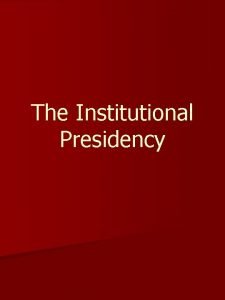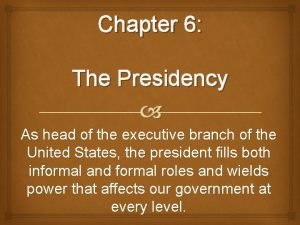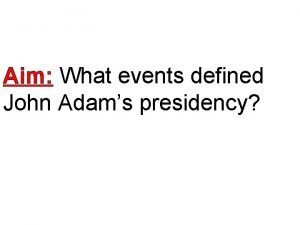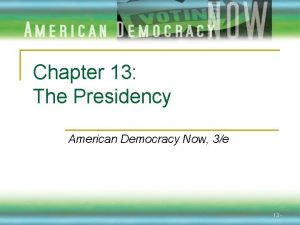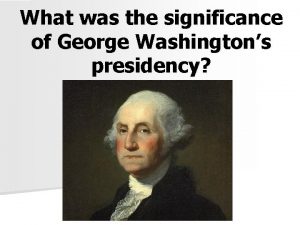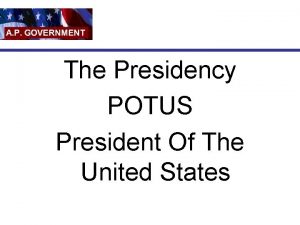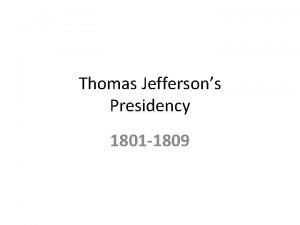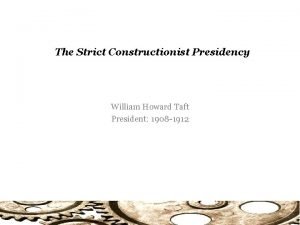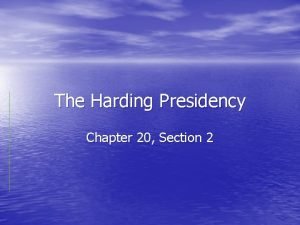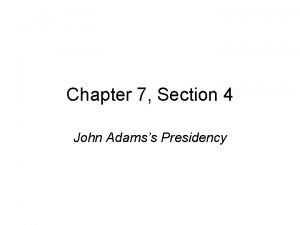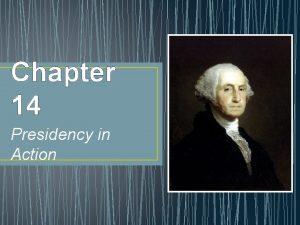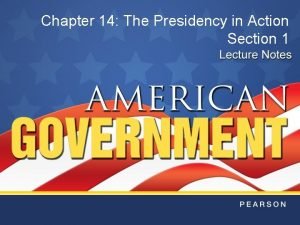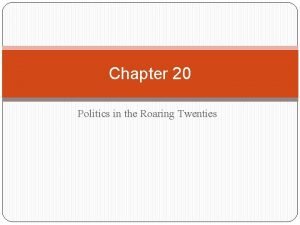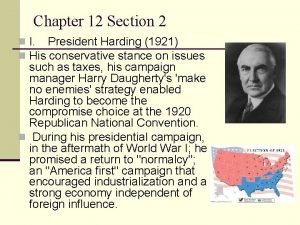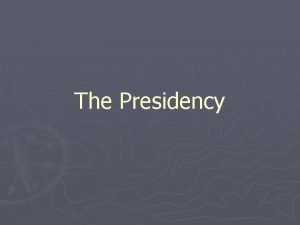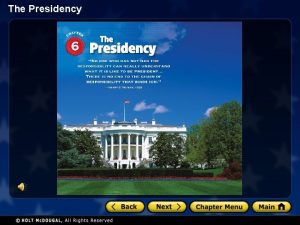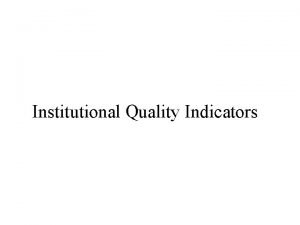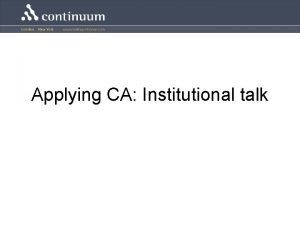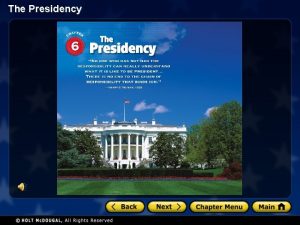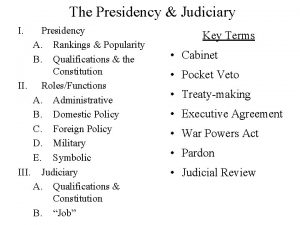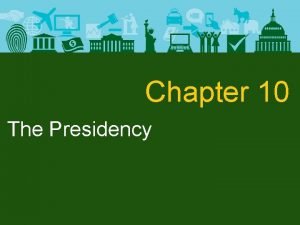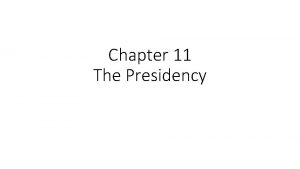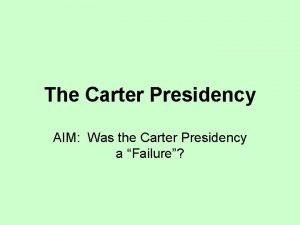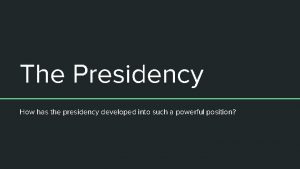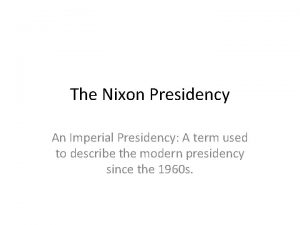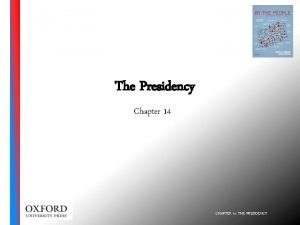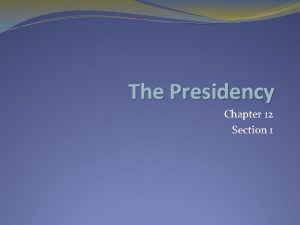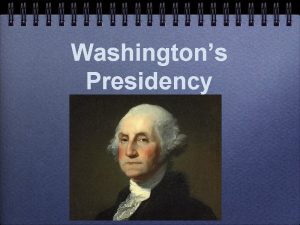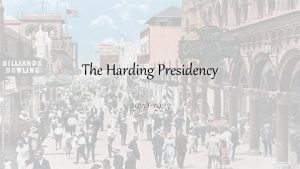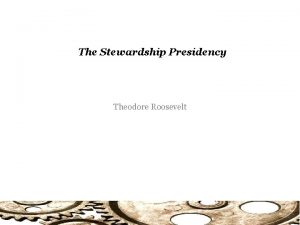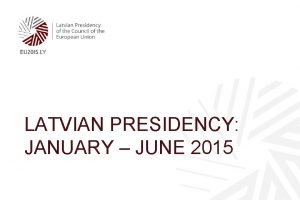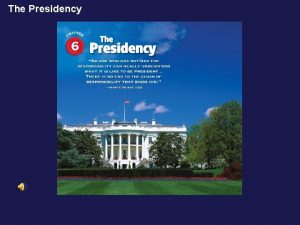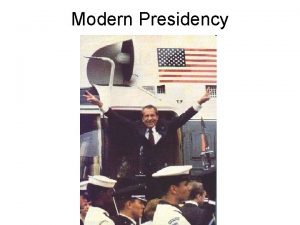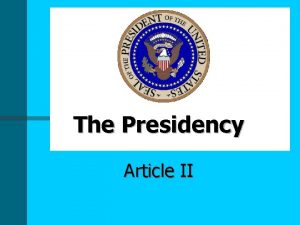The Institutional Presidency Evolution of the Institutional Presidency























- Slides: 23

The Institutional Presidency

Evolution of the Institutional Presidency n The institutional presidency is the a term commonly applied to the White House, Office of Management and Budget, and other elements of the Executive Office of the President-for example the Council of Economic Advisors and the National Security Council. n Less commonly, it also refers to patterned behaviors that link the presidency to other parts of the political system. The relation to the OMB, for example, is quite regularized in its interactions with the bureaucracy, while many other structures are ephemeral in their relation to the presidency.

n Corwin estimates that 1 of every 3 presidents has been responsible for expansion of executive authority through time. Still some presidencies have been more expansive than others. n Washington- He quickly filled in the “silences” of the Constitution by establishing precedents. n The Constitution made no provision for an advisory body to the president. This was left vague intentionally with the statement “request the opinion in writing” of those in the executive branch. Washington turned to his Department Heads for advice to establish a “cabinet” like government. He went beyond the Constitutional charge to “request the opinion in writing”.

n Congress established: Department of State, Department of Treasury, Department of War, Post Office, Attorney General-1789 ; Department of Navy-1798 ; Department of Interior-1849 ; Department of Agriculture-1862 ; Department of Commerce and Labor 1903 ; Department of Commerce, Department of Labor 1913 ; Department of Defense-1947 ; Department of Health, Education, and Welfare-1953 ; Housing and Urban Development-1965 ; Transportation-1966 ; Energy-1977 ; Health and Human Services-1980 ; Education-1980 ; Veteran’s Affairs-1988 ; Homeland Security-2002 n The heads of these Departments, called Secretaries, are called the Cabinet. n During the 19 th century and until the mid 20 th century, presidents relied extensively on their cabinets for advice. n Recall our earlier discussion of the White House and how little personnel support that presidents had until the F. D. Roosevelt administration.

n From 1787 to 1857 the president’s staff was very small and they were paid out of the president’s own pocket. No public funds were authorized for presidential staff or support. The phrase in the constitution “The President shall, at stated Times, receive for his Services, a Compensation, which shall neither be increased nor diminished during the Period for which he shall have been elected, and he shall not receive within that Period any other Emolument from the United States, or any of them. ” was taken as a prohibition on support for the president. n Nevertheless, in 1857 Congress passed a law that provided funds for a private secretary to the president, a steward, and a messenger. n This was seen as precedent, and the staffing of the institutional presidency continued through the years.

n Still, until the FDR administration, staffing was meager. Staff were mainly clerks for the purpose of answering mail, etc. Grover Cleveland answered his own telephone. Woodrow Wilson typed his own letters. n By the 20 th century, the job of presidential secretaries had turned to drafting speeches, regulating access to the president, and on occasion providing advice. n As late as 1922, the official staff to the presidency was only 31. n The Budget and Accounting Act of 1921 sharply altered one dimension of support for the president. It established the Bureau of the Budget for the purpose of assisting the president in formulating a presidential budget for submission to Congress.

n When Franklin Roosevelt came to office in 1933, a recognizable albeit small presidential staff existed. It was slowly growing in size and beginning to show signs of specialization and division of labor. n Nevertheless, Roosevelt felt overwhelmed because of the growth in government and multiple tasks the president was required to perform. n In 1936 Roosevelt designated a commission of scholars (Louis Brownlow, Charles Merriam, and Luther Gulick) to study the problems of governmental organization and support for the president. The Brownlow Commission reported back to the president in January 1937 with a set of recommendations.

n The Brownlow report is among the most important documents relating to the evolution of the institutional presidency and marks the hey day of influence from the academic fields of political science and public administration. n The Brownlow report recommended the creation of a staffing system to help the president with: – Increased executive tasks – Managerial functions such as budgeting, personnel, research, planning, efficiency – Extension of the merit civil service system – Revision of the fiscal system, especially auditing and record keeping.

n The Brownlow report was controversial, seen by some in Congress as a power grab on the part of the presidency. n A much watered down set of recommendations for support of the presidency was passed by Congress in April of 1939. n The Reorganization Act of 1939 gave the president authority to reorganize the executive branch, subject to a legislative veto. Note that this authority was renewed each year through 1980. n Reorganization Plan No. 1 under this legislation established the Executive Office of the President (EOP). This plan transferred pre-existing agencies, the Natural Resources Planning Board and the Bureau of the Budget to the EOP.

n The creation of EOP marked the beginning of a large staffing and support system for the president. n Here is a link to a history of the EOP through time (https: //www. fas. org/sgp/crs/misc/98606. pdf ). Of special note are the following creation dates: – – – – White House Office-1939 Council of Economic Advisers-1946 National Security Council-1949 Council on Environmental Quality-1969 Office of Management and Budget-1970 Office of the Special Representative for Trade Negotiations-1975 Office of Science and Technology Policy-1976 Office of Administration-1977 Office of National Drug Control Policy-1988 National Economic Council-1993 Domestic Policy Council-1993 White House Office of Faith-Based and Community Initiatives-2001 Homeland Security Council-2001

n Of the 45 changes in EOP through time, 16 have occurred through public laws, 16 have occurred through executive orders, and the remainder occurred through reorganization plans. Implications? n The EOP has grown in staff and budget since 1939. Official data in 2017 put the EOP budget at $714 million, with about 1, 869 full time employees. Of these, about 450 are with the White House, 490 are with OMB, 240 are in the Office of the Trade Representative, 234 are with the Office of Administration, 96 are with the Executive Residence, etc. Here are links to the EOP and White House. n The EOP is overseen by the White House Chief of Staff. The chief of staff is the highest ranking assistant to the president. n The office was created in 1946 by then president Harry Truman.

n Of course, the part of the EOP closest to the presidency is the White House Office, headed by the chief of staff and consisting of around 450 persons who manage the daily affairs of the president. This office consists of the following staff and suboffices: – – – – – – Chief of Staff Cabinet Secretary Counsel to the President Office of Communications Office of Intergovernmental Affairs Office of Legislative Affairs Office of Political Affairs Office of Presidential Personnel Office of Public Liason Office of Scheduling Office of Special Projects Office of Speechwriting Press Secretary Staff Secretary Director of the Domestic Policy Council Director of the National Economic Council National Security Advisor Office of Administration Special Envoy to the Americas Advance Office Senior Advisor to the President for Policy and Strategy – Senior Advisor to the President for Policy Development

n From the standpoint of policy, there are three offices within EOP that are more important than the others. These are the Office of Management and Budget (OMB), the Council of Economic Advisors, and the National Security Council. n The OMB, which replaced the Bureau of the Budget in 1970, does the following: – Budget development and execution. – Management, including oversight of agency performance, human capital, Federal procurement, financial management, and information technology. – Regulatory policy, including coordination and review of all significant Federal regulations by executive agencies. – Legislative clearance and coordination. – Executive Orders and Presidential Memoranda. n The offices that perform these functions are listed at the following link: https: //www. whitehouse. gov/omb/offices /

n OMB and budget formulation, execution, and auditing. n At any one time, OMB is formulating the next fiscal year’s budget, executing the current fiscal year’s budget, and auditing the last fiscal year’s budget. Here is a link that explains the process. https: //www. senate. gov/reference/resour ces/pdf/RS 20152. pdf OMB monitors agency performance through the Office of Performance and Personnel Management. n OMB requires that federal agencies submit a report detailing their financial and program performance results for the prior fiscal year. OMB also requires that federal agencies compile annual financial statements. Office of Federal Financial Management Financial Reporting -

n Legislative Clearance- – Before an agency of the executive can submit legislation for consideration by Congress, it must be approved by the Legislative Reference Division within OMB. – OMB also reviews legislation passed by Congress and makes a recommendation to the president concerning whether it should be signed or vetoed.

n Regulatory Clearance– Beginning with the Ford administration OMB has contained an office assigned to perform cost-benefit analysis of major rules coming out of the executive branch. – EO 12291 during the Reagan administration greatly accentuated this review process by creating a new office (OIRA) and making explicit which rules should be reviewed. Reviewed 2 -3 thousand regulations per year. – All presidents since Reagan have maintained this function, with the definition of major rule being changed and made more inclusive by fresh executive orders from each presidency. Clinton’s was EO 12866 - Reviewed fewer 500 -700 annually. Bush’s was EO 13, 422. Congress overturned his order giving OIRA additional powers. Obama’s was EO 13563, which explicitly renewed Clinton’s. – Trump issued the so-called two-for-one executive order that’s already under judicial challenge by lawsuit.

n Management, including oversight of agency performance, human capital, Federal procurement, financial management, and information technology. See offices at https: //www. whitehouse. gov/omb/offices n Executes Executive Orders and Presidential Memoranda. Sometimes left to fill in the details. Supervises their execution by administrative agencies. – The executive order process usually begins with a meeting among all the agencies who may play a role in implementing the directive. – The Office of Management and Budget will typically ask relevant agencies for their feedback — often under a tight deadline. – OMB is typically well-practiced at receiving and synthesizing feedback from the agencies and then summarizing it for policymakers so they can make decisions, he added. – Just because agencies have given feedback does not mean that feedback will be heeded.

n Council of Economic Advisers- This organization was created as a result of the Employment Act of 1946 which charged the president directly with maintaining “full employment”. Three members appointed by the President, with the advice and consent of the Senate. Trump has not yet appointed. It is charged with the following: – Assist the president in formulating an annual economic report to Congress that is required by law. – Collect and analyze economic data – Monitor federal programs for consistency with the Employment Act of 1946 and later the Humphrey-Hawkins Act of 1978. – Recommend economic policies to the president. Provide the president with whatever economic advice he asks for.

n National Security Council- This organization was initially created after World War II owing to congressional frustration with Roosevelt’s management of the war. However, it was moved by President Truman to the EOP in 1949. This was a response to the onset of the “cold war. ” See also: https: //en. wikipedia. org/wiki/United_Stat es_National_Security_Council – The mandate of the NSC is to “advise the president with respect to integration of domestic, foreign, and military policies relating to national security. ” – Roughly a dozen people serve on the NSC, including the president, vice-president, secretaries of State, Defense, and Treasury, the UN ambassador, the CIA director, chairman of the Joint Chiefs of Staff, assistant to the president for national security affairs, assistant to the president for economic affairs, and the White House Chief of Staff. n The CEA and NSC both illustrate how Congress can make its demands felt on the EOP. Both organizations were congressionally created to fulfill new obligations on the presidency.

n The Vice-President and First Lady are also closely associated with the White House. n Vice-Presidents have traditionally not been very involved in the operation of the White House. Neither have First Ladies. n Your text contains some discussion of these actors and their changing roles.

Why has the presidency developed as an institution since 1787? n Judicial influence-It was not until 1937 and several important Supreme Court decisions that government expanded. Government expansion meant expansion in the presidency. n Interest groups-Government has expanded and often represents interest groups. The plural presidency concept. n Presidential initiatives-Washington, Jefferson, Jackson, Teddy Roosevelt, Wilson, and Franklin Roosevelt. n Expansion through statute-Budget and Accounting act of 1921, etc.

Staffing the EOP n Presidents have used three basic models to organize the White House staff. Collegial model-Kennedy used, and Carter and Clinton began with. Competitive system-Roosevelt used this. Formal, Centrally Managed system. Eisenhower, Reagan. n Collegial system-Small group of aides who work informally together to advise the president, plan and coordinate administration positions and responses. Key ingredient is working together. Team approach. Generate loyalty without centralized control. Most collegial staffs come directly from the president’s campaign. True believers. Lack of experience. Team may be too cohesive, perceptions too uniform so that the president does not get the gamut of advice. Group-think. n Did this phenomenon lead to the Bay of Pigs fiasco? Vietnam? White House response to Iraqi invasion of Kuwait?

n Competitive model-Broadly seek advice from those who are adversaries. Adversaries have a strong incentive to flesh out all information. Then, collect information, analyze, and make a decision. Problem with this model is that only Roosevelt was adept enough to use it. n Centrally Managed Hierarchical system. All information is directed upward through a rigidly organized hierarchical system in which a single presidential advisor filters information to the president. Homework is done below; decisionmaking is done above. Problem is that it can be too efficient so that decisions are already made before they reach the president. Aggravates the proclivity toward isolation for the White House. n Was this type staffing system partially responsible for the Watergate cover-up?
 Institutional presidency definition
Institutional presidency definition President informal powers
President informal powers Xyz affair summary
Xyz affair summary American democracy now chapter 13
American democracy now chapter 13 What was the significance of george washington's presidency
What was the significance of george washington's presidency Presidency line of succession
Presidency line of succession What were president jeffersons economic policies
What were president jeffersons economic policies Washingtons presidency
Washingtons presidency Strict constructionist
Strict constructionist Chapter 12 section 2 the harding presidency
Chapter 12 section 2 the harding presidency Section 4 the presidency of john adams
Section 4 the presidency of john adams Chapter 6 section 1 the presidency
Chapter 6 section 1 the presidency Apush chapter 7 hammering out a federal republic
Apush chapter 7 hammering out a federal republic Chapter 14 the presidency in action answer key
Chapter 14 the presidency in action answer key Chapter 14 the presidency in action
Chapter 14 the presidency in action Chapter 20 section 2 the harding presidency
Chapter 20 section 2 the harding presidency Chapter 12 section 2 the harding presidency
Chapter 12 section 2 the harding presidency Từ ngữ thể hiện lòng nhân hậu
Từ ngữ thể hiện lòng nhân hậu Bổ thể
Bổ thể Tư thế ngồi viết
Tư thế ngồi viết Thế nào là giọng cùng tên
Thế nào là giọng cùng tên Thể thơ truyền thống
Thể thơ truyền thống Bài hát chúa yêu trần thế alleluia
Bài hát chúa yêu trần thế alleluia Hươu thường đẻ mỗi lứa mấy con
Hươu thường đẻ mỗi lứa mấy con
